
Play fair...
...with your heirs
My most informative discussions about pricing occur with people who don’t know much about collectibles, particularly people who have inherited collections.
All too frequently, discussions revolve around misunderstandings of value. Many times I learn that collectors over-estimated values of their collections, proudly told their prospective heirs, and then unceremoniously died.
Collectors often refuse to sell their own collections. In death they force the job on their heirs, as if heirs weren’t already busy. Most heirs know little about their loved one’s collections and even less about how to sell them. Among my most irksome experiences is learning how collectors gave heirs’ inflated expectations of value. Inflated valuations may seem like innocent exaggerations until you learn how many survivors may be counting on those proceeds for living.

Plain share panel typical of most local printers. From an 1871 stock certificate of the Providence Warren & Bristol Railroad Co.
Let’s say collectors suggested their holdings were “worth $10,000.” Estimates usually represent retail value. Collectors seldom tell their heirs to expect wholesale values when they sell. After all costs are considered, proceeds will probably end up being 50% to 70% of retail. That means heirs should probably expect to net $5,000 to $7,000 on $10,000 collections. (Add or subtract zeros as you desire.)
That amount would probably be acceptable, except that my experience suggests that most collectors substantially over-estimate values. If collectors over-estimate retail values by 30%, then retail values ought to be about $7,700. (Many collectors exaggerate much more than 30%!) Depending on how they sell, heirs may net as little as $3,850 on $10,000 collections (50% of $7,700). Obviously, huge gaps between expectations and reality can devastate heirs. While over-estimation may seem innocent, I will excuse heirs for calling it something very different. I strongly suggest collectors be brutally honest with their heirs.
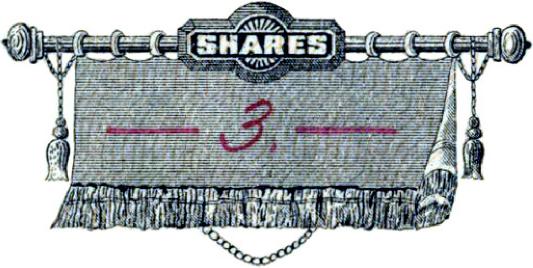
Wonderful Victorian share ornament from a 1904 stock certificate of the Baldwin & Rowland Switch & Signal Co.
Why the disconnect?
Admittedly lacking statistics, I personally feel that most collectors, including myself, over-estimate the values of our collections. Obviously, we want to feel that we make good decisions. We want to convince ourselves that we know and appreciate our hobby and that we have knowledge of fair prices. If all that were true, we would not over-estimate so readily. Truth be told, I think the tendency to over-estimate values actually reflects several key misunderstandings about the hobby.
394 New certificate varieties since January
|
January
letter |
This
letter |
| Number of certificates listed (counting all variants of issued, specimens, etc.) |
23,435 |
23,869 |
| Number of distinct certificates known |
17,812 |
18,150 |
| Number of certificates with celebrity autographs |
1,720 |
1,733 |
| Number of celebrity autographs known |
348 |
346 |
| Number of railroads and railroad-related companies known |
26,117 |
26,171 |
| Number of companies for which at least one certificate is known |
7,385 |
7,469 |
| Serial numbers records |
93,355 |
95,885 |
Misunderstanding of who establishes value
I suspect that when collectors estimate values of their collections, they play roles of imaginary sellers. Collectors know about rarity, autographs, conditions, frequency of appearance and so forth. They look at items in their collections and imagine conferring that hard-won knowledge on potential buyers. It feels good to imagine buyers lining up to buy their collectibles at full retail prices. Or more.
While an appealing daydream, the truth is very different. Sellers merely suggest prices. Buyers set prices. Sales occur only when buyers pull money out of their pockets.
When valuing collections, collectors appear to develop selective amnesia. Seemingly, they forget how they formed their collections in the first place. When building collections, all collectors, regardless of wealth or experience, endeavor to pay the very least. Collectors never willingly pay full retail.
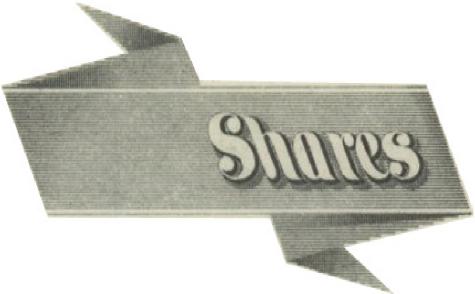
Share ornament from 1882 stock certificate from The Chesapeake Ohio & Southwestern Railroad Co.
Let me state this one more time for emphasis. Heirs-turned-sellers (or collectors) can never make sales happen. They can prevent sales by their price structures, attitudes, advertising, and sales practices, but they cannot make sales happen without agreements with buyers. Buyers control all transactions.
Believing that ownership adds value
There is a nearly-universal delusion that we collectors perpetuate on ourselves. I call it the “Because I Own It” delusion. It happens as frequently to me as it does with my correspondents.
I see an item priced at $15 that I think should be worth $30. I negotiate the price to $10 and make the purchase. The item immediately goes into my mental ledger book as a $30 collectible. (Add zeros as appropriate.)
“Value” suddenly blossomed by 3x. Within seconds! Yet absolutely nothing changed about the collectible except ownership. What is so special about my ownership?
The only reason that I found the item for sale in the first place was because no one wanted the item at $15. It is quite possible that no one even wanted to pay $10. At the instant I made the purchase, I became THE high bidder. What could possibly make me think there is a higher bidder waiting to pay $30?
Yes, I can hear some of you shouting, “There CAN be a higher bidder out there! There can, there can, there can!” True, but can I or my heirs find that potential buyer in a reasonable amount of time? How much effort will it take? How much will it cost? It won’t be free! If I leave the task to my heirs, then my specialized knowledge and ownership added nothing.
I can delude myself as much as I want, but the reality remains. The only reason I found the item for sale in the first place was because no one else wanted to pay the ask price.

Share ornament from 1906 stock certificate of The Burlington & Western Railway.
Now I can hear you shouting, “Yes, but too few people knew of your collectible’s existence prior to your arrival!” I agree completely. In fact, I have made that point countless times about collectibles offered for sale on eBay. My correspondents routinely buy rarities on eBay at absurdly low prices simply because too few people found those items within typical 7-day sale periods.
So how can collectors think it will be any different when the time comes to sell their holdings? Or, worse, when they give the task to someone less knowledgeable? While our ownership as collectors theoretically adds value because of our enhanced knowledge, every bit of that value disappears when we let someone else handle disposition.
We clearly have a tendency for self-delusion and selective amnesia. If we make great purchases and manage to convince ourselves that our ownership enhances value, why don’t we remember our bad purchases? Every collector, alive or dead, has paid too much for something that later turned out to be less desirable, less rare, and less valuable than initially thought. Why don’t we enter those purchases in our imaginary ledger books?
Misunderstanding the role of rarity
The greatest single misunderstanding in our hobby, bar none, revolves around the relationship between rarity and value. I have discussed this issue at length in previous newsletters, so I won’t re-argue the point.

Extremely few collectors truly appreciate the reality that value depends on desirability. Rarity is nothing more than one of many factors that affects desirability.
In our hobby, extreme rarity is extremely common. My research suggests that at least HALF of all certificate varieties reported so far are represented by five or fewer examples. In other words, as many as half of our certificate varieties are as rare or rarer than 1913 V nickels!!! Yet, unless certificates carry celebrity autographs, extremely rare varieties seldom sell for more than $2000. In hobbies like coins or stamps, rarities of that magnitude routinely sell for hundreds of thousands, sometimes millions, of dollars.
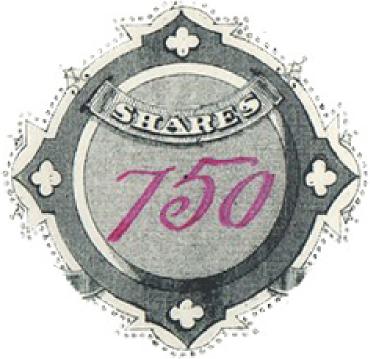 Share ornament from 1885 stock certificate from The Cleveland Indiana & St Louis Railroad Co.
Share ornament from 1885 stock certificate from The Cleveland Indiana & St Louis Railroad Co.
It is hard to get the mind around a hobby where half of the known varieties are represented by five or fewer extant examples. And yet, almost every intermediate collector owns some of those rarities. It is ironic to have a hobby where rarities are common. Rarities are so common, in fact, that rare certificates routinely sell for less than $50! Not all extremely rare certificates are greatly desirable, therefore not all extreme rarities are worth much!
About 700 weeks have elapsed since the first edition of my catalog appeared. During that period I have had at least 700 correspondences in which collectors suggested high values because of rarity. When collectors argue that certificates are worth more because they are rare, I wonder about disappointments they or their heirs might experience in the future. Will they prove me wrong or will they discover that rarity does not necessarily add value?
Thinking the market is deeper than it really is
I don’t know anyone who has publicly estimated the number of serious and casual collectors in the stock and bond hobby. Within specialties, collectors may number fewer than a dozen to maybe a couple thousand individuals. In other words, the number of collectors interested in any particular certificate is unknown, but certainly not very large. Compound that uncertainty with the realization that many buyers are only occasional collectors and many are less than serious.
With such a mysterious population of collectors in any given specialty, how can ordinary collectors possibly estimate sales prices? After all, only a fraction of potential buyers will be interested in particular certificates no matter how desirable. Some may already own certificates like them. Some won’t be able to afford them. Most will try to “steal” them with lowball bids and offers. Unless certificates are sold by major auction houses, the great majority of collectors will never even learn particular certificates are for sale.
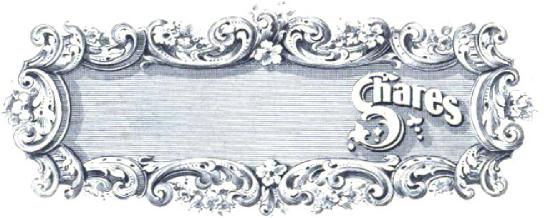 Share ornament from 1868 stock certificate of the Buffalo & Erie Rail Road Co.
Share ornament from 1868 stock certificate of the Buffalo & Erie Rail Road Co.
I suggest there are fewer collectors interested in any particular certificates than most collectors realize. For that reason, I suggest it is near certainty that collectors will over-estimate the depth of the market.
Estimating current values
Obviously, I offer estimates of retail values in my catalog and web site. I think about prices constantly and adjust prices in the online database frequently. However, I estimate prices for the United States as a whole. My prices will rarely match your specialized buying and selling situation.
I actually think there is a better way for collectors to estimate current values. I suggest collectors take the amount they originally paid for each item, including commissions, and factor in inflation over their period of ownership. Let’s say a collector bought a certificate 20 years ago for $100. If inflation averaged 3.5% during that period, then the estimated value of that certificate is currently about $198. ($100 grew to $103.50 the first year, $107.12 the second year, and so forth.) The by-product of using this simple method is that it greatly diminishes the risk of overstating value.
You may think that a $100 certificate held in a collection for 20 years should be worth much more than $198. You may be correct. But how many less desirable items does the collection hold? Has there been any serious price declines during the holding period?
Most collections include many items of low desirability. Collectibles of limited desirability do not seem to keep pace with inflation. Let’s also remember that values of collectibles constantly rise and fall and prices have been flat to down for eight or nine years.
Unfortunately, falling prices magnify the likelihood of over-estimating the current values of collections. In turn, over-estimation magnifies the likelihood of disappointment for collectors or heirs forced into selling at this time. I beg collectors to estimate realistic potential values. Please warn heirs how much to expect to receive if something happens to you and circumstances force them into liquidating your collection.
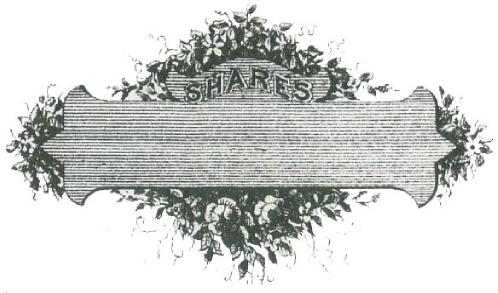 Share ornament from Ashburnham Rail Road Co. stock certificate.
Share ornament from Ashburnham Rail Road Co. stock certificate.